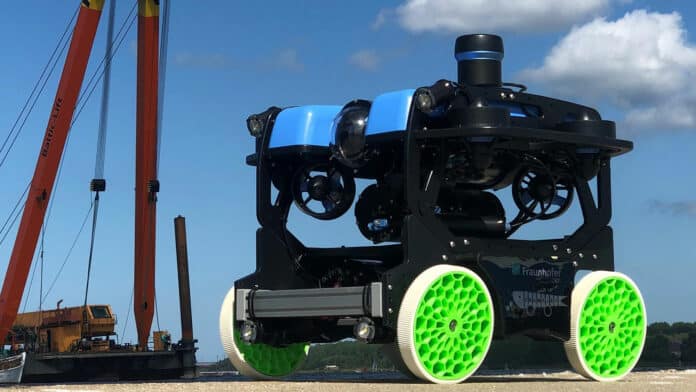Offshore plants play a crucial role in realizing the energy transition. It is essential to carry out periodic inspections, repair corrosion protection, and examine welds to help ensure the longevity of these plants. However, much of this underwater work is still conducted by industrial divers, making maintenance time-consuming, expensive, and risky.
To address this challenge, the Fraunhofer SOT developed an underwater vehicle called “Crawfish” for maintenance work such as cleaning, repairing, and coating.
The “Crawfish” underwater vehicle is an extension of the open-source “BlueROV2” remotely operated vehicle made by California-based company Blue Robotics. The mechanical design of the wheels and axles makes it possible to control the robot precisely, let it drive on various offshore structures, and perform precise maintenance work.
The robot uses four direct-drive wheels to move freely on flat and curved surfaces, with the ability to generate contact pressure via four vertical thrusters in order to be independent of the surface conditions. The “Crawfish” has already undergone successful testing in the Baltic Sea at the research platform in the artificial reef off Nienhagen.
The robot is so lightweight at only 22 kg (48.5 lb), making it possible for just two or three people to lower it into the water without needing a crane. Once it’s underwater, an operator can remotely control it to move toward the structure with the help of the BlueROV2’s camera and thrusters.
When the robot reaches the vertical surface of the platform, it uses its thrusters to apply up to 90 Newtons (20 lb-force/9 kg-force) of force, which keeps the Crawfish securely in place against the surface. Then, the robot continues its journey along the surface by using its powered wheels.
The robot’s camera is utilized to remotely inspect the structure’s anti-corrosion paint for damage. Additionally, the robot’s reader head is capable of wirelessly collecting data from CoMoBelt sensor collars installed at various points on the platform. These collars use ultrasonic transceivers to detect cracks in seam welds.
If any damage is detected in the anti-corrosion paint, it can be repaired with a specialized two-part coating material that can be injected into the robot’s remotely operated brush. The robot also has an onboard welding head, which can potentially be used to fix faulty welds.
The Crawfish robot can currently descend to a maximum depth of 50 meters (164 feet) and crawl (using 50 Newtons of downforce) for 25 minutes on a single battery charge.
The “Crawfish” underwater vehicle has a versatile range of applications. One of them involves reading out monitoring systems such as the CoMoBelt sensor collar, which can detect cracks in weld seams through its ultrasonic sensor technology.
To read the cuff, a reading head is used that supplies energy via induction and reads out the measurement data via WLAN. This reading head can also be attached to the ROV and placed precisely above the cuff under water.
